Qtek S200 review: A genuine tool box
Easy control
Doubtlessly, the new OS facilitates a lot the control of the device without the necessity of using a stylus. At the same time, manufacturers tend to not pay enough attention to users' aftermarket needs. The Windows Mobile 5 OS is only controllable without a stylus in case that hardware keys have been assigned the OK/Close and Start functions, a crucial detail, which manufacturers seem not to bare in mind. Qtek 9100 is the perfect example.
Once the above mentioned functions have been assigned to the respective keys, 9100 becomes relatively comfortable to control. And trust me that I know why I am using exactly the word "relatively"...those keys are just located much too far... In this order of thoughts Qtek is the first communicator of its series, where designers seem to have thought details over after having tested the device in practice. The evidence of their efforts is the two unobtrusive buttons mounted beneath the five-way controller, which convert the control process into real pleasure.



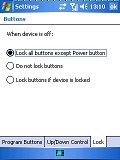
Assigning Functions to Hardware Keys
As a matter of fact, a major part of daily used applications can be run and used without using the stylus. Nevertheless, one still finds gaps; for example, the switch between received and sent messages is unthinkable without the stylus. Even though Qtek S200 has more than one of these drawbacks, I can honestly say that stylus usage has been minimized.
Writing on the display
Qtek S200 has no hidden numeric keypad. Text is inserted by means of the touchpad display. Just to be sure, please let me repeat how this is done for all those not acquainted with PocketPC input modes. Those familiar, please, feel free to skip the following pair of paragraphs.


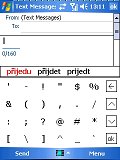
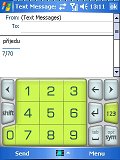
Virtual keypad for thumb typing
When you need to insert text, use the virtual mobile phone keypad. On the display you will see large keys representing functions similar to those offered in any common handset. The writing process alone is carried out by tapping with thumb on the display (it is here, where you will come to appreciate the protecting folio, on which fingerprints are less visible.). At the beginning you will probably experience certain discomfort as keys give no physical feedback. In general, however, a slight touch is sufficient for the respective character to be written down.
What creates more problems is the lack of borders between keys, due to which your thumb has nothing tangible to distinguish the keys. To me personally, getting used to writing on S100 took me a few months. But once I had caught the right technique, I was able to write on the touchscreen as fast as I would do on the standard keypad of any common mobile phone.


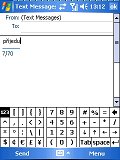

Menu with methods of text insertion, virtual QWERTY keypad with its petty keys
Another writing option available in Qtek is the small QWERTY keypad with its truly petty keys, manageable through the use of a stylus only. I have to confess, however, that choosing the right key costs me enormous efforts, even if I am at the quietest and calmest place possible. In MHD, for example, this type of writing comes naturally. Windows Mobile is designed to also recognize hand written characters, an option, which I myself found hard to get accustomed to. Yet I know users who literally love it. The last option available is called Transcriber, that is, a program, which recognizes written characters, including entire hand-written words. To my opinion, Transcriber is the least reliable writing method among all above mentioned options.



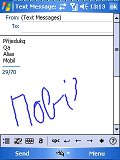
Two methods of recognition of characters and written words
In conclusion, let me point out that any hardware keypad is generally better than all soft-methods of text input taken together. If you usually write longer emails, chat on ICQ or write novels, then make sure you pay a special attention to Qtek 9100 as its keypad is praiseworthy.
Phone calls
Let us now take a closer look at Qtek S200 as "a common mobile phone". Qtek S200 is equipped with a communication module supporting 850/900/1800/1900 MHz GSM frequency bands. In other words, it meets even the requirements of travelers to remote destinations. The shared memory does not limit in any way the number of the contacts stored. Each name can be assigned dozens of fields. Two new fields have been added with the launching of the new Windows Mobile 5 OS: a picture and a ringing melody (both of which used to be supplied through an external application in older OS. All contacts, including all fields attached to them, get seamlessly synchronized with Outlook.




Each contact can be assigned several dozens of fields
Dialing process is fast: you need to switch on the communicator, press the green receiver, which opens the virtual keypad; here you have to look up the respective contact ("T9" fastens up the entire process) and dial it by another press on the green receiver. Searching process using "T9" is similar to message writing. The key with the letter included in the searched name should only be pressed once. The phone then starts to automatically filter all corresponding contacts, no matter whether you have entered the first or the last name of the searched person.

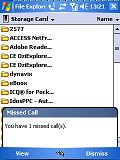

Interface for contact search, missed call, and call register
Qtek S200 can be setup to alert about incoming calls by a melody in WAV format, by a MP3 file, or by WMA and vibrations. As to the state-of-art call functions, here I sort of miss ringing profiles (applications like PhoneAlarm and PocketZenPhone are possible to install additionally). I would have not turned down call filtering either.
Thanks to Bluetooth Qtek S200 communicates smoothly with a wireless hands-free (personally tested on Nokia BH-200). Available also is a built-in handsfree (with a long press of the green receiver for about 2 seconds) and a light headset that comes along with the communicator. Sound is rather tinny, lacking bass elements, and generally deserves a rather lower mark.
At the beginning, communicators based on the Windows Mobile 5 platform used to have problems with call receiving speed. The first versions of Qtek 9100 were especially bad: if, for example, it was to receive a call while running a rather complicated application, it would really take it plenty of time before it displayed the information bubble and reacted to the press on the green receiver. In this respect Qtek S200 shows no problems. Ringing tone is heard immediately, even in case of simultaneously running energy-consuming video.
Reader comments
- Arunakumar
- 23 Jun 2014
- 7wA
I want this mobile batteries where can i getting.
- Arunakumar
- 21 Jun 2014
- 7wA
I want this mobile batteries where can i getting.
- Anonymous
- 28 May 2012
- Xum
why online video is not saported in my mob..... plzzzzzz...... slv my prb